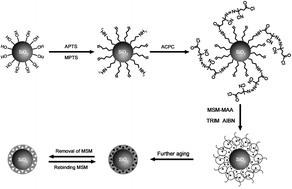This work presents an approach called “hybrid design” which combines “grafting from” and “grafting through” methods, in order to prepare highly dense imprinted layer-coated silica particles for improved binding capacity to metsulfuron-methyl (MSM). The imprinted conditions including the kind of solvent and molar ratio of template to functional monomer were carefully optimized by quantum mechanics method. The obtained imprinted materials were evaluated by transmission electron microscopy and rebinding experiments, exhibiting well-controlled shell thickness (up to ∼30 nm) and high binding affinity to MSM. Moreover, the rebinding amount of MSM-imprinted particles to MSM was nearly 1.6- and 1.4-folds that of normal surface-imprinted particles, respectively. When the MSM-imprinted particles were used as dispersive solid-phase extraction materials, the recoveries (RSDs) of MSM determined by high-performance liquid chromatography (HPLC) were 93.4% (1.5%), 86.8% (3.2%) and 88.4% (2.7%) in the spiked water, soil and wheat samples, respectively. Therefore, the method will provide new opportunities for enrichment and detection of trace MSM from complicated matrices.

You have access to this article
 Please wait while we load your content...
Something went wrong. Try again?
Please wait while we load your content...
Something went wrong. Try again?


 Please wait while we load your content...
Please wait while we load your content...